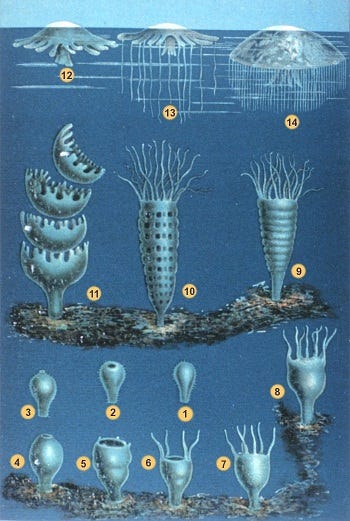
The Portuguese Man O’ War. A truly awesome name. Just looking at it makes you cringe at the thought of even brushing those long, stinging tentacles, signature organs of a jellyfish. However, this ‘it’ is not really an it but more of a ‘they’. Actually for that matter, “they’re” not even a jellyfish, they’re a siphonophore.
What the heck is a siphonophore?
Siphonophores are creatures affiliated with the class Hydrozoa, a class belonging to the phylum Cnidaria. Additionally, these creatures share this phylum with two other similar classes; Anthozoa (corals & sea anemones) and Scyphozoa (true jellyfish). Before this phylum branched off into these three distinct classes, all three shared the same type of life-cycle. In the concise words of Stephen Jay Gould:

“The cnidarian life-cycle features a so-called alternation of generations. The sessile polyp, a fixed cylinder with a fringe of tentacles, reproduces asexually and generates by budding the free-swimming medusa, or ‘jellyfish.’ The medusa produces sexual cells that unite and grow into a polyp. And so it goes.”
Today , however, these three classes each have differing life-cycles. Anthozoans, or modern day sea anemones and corals, have abandoned the medusa stage, and Scyphozoans have discarded their sessile polyp stage. Hydrozoans on the other hand, retain that original cycle. This results, unsurpirisingly, in a confusion between the medusae in class Scyphozoa and the medusae in class Hydrozoa. So if they look similar enough to be mistaken for one another, what differentiates the two?*
Men of War, Not Man
The key to their differences comes from the statement I made earlier this essay: “However, this ‘it’ is not really an it but more of a ‘they’.”
Jellyfish are creatures that have true organs; each body part — mouth, sex organs, tentacles, etc. — is comprised of cells dependent on each other to survive. The Portuguese Man O’ War; however, is a little more complex than an aggregation of well organized dependent cells.

The Portuguese Man O’ War is composed of three types of polyps and a ‘pseudopolyp’ of sorts. The ‘pseudopolyp’, as we’ll call it, is the sail or buoy part of the Man O’ War; it allows the creature to float and has the ability to deflate in order to avoid aerial attacks. The other three polyps each have their own functions: reproduction, digestion/ingestion of food and defense (tentacles full of cnidocytes, or stinging cells). That information is fairly simple to digest, but here is where it gets complicated.
Each polyp is comprised of “genetically identical individuals called zooids”, each of which are highly specialized in order to carry out that polyp’s function (National Ocean Service). A zooid is essentially a multicellular organism that collaborates with others in a colony. The complex bit is that these autonomous zooids can not survive independently as they are so highly specialized.
An example of this autonomous behavior can be found in the eating habits of the Man O’ War. When a Man O’ War nabs some prey, the food is dissolved by venom released by each cnidocyte in the tentacles, and the remaining sludge is spread to each individual zooid in order to be digested. And yet these individual zooids share a central nervous system, in addition to their own nervous system.
This leads us to two significant and intriguing conclusions. Firstly, the Portuguese Man O’ War is very different than a jellyfish. Secondly, the Portuguese Man O’ War is somewhere in between a single organism and a highly specialized colony. Despite this paradoxical situation, biologists have pretty much agreed to say that the Portuguese Man O’ war is a single organism, albeit a complex one.

*Within each of the aforementioned classes, there are exceptions to their general life cycle described, an example being the Portuguese Man O’ War. However those discrepancies are not within the scope of this essay, and do not have a significant effect on the argument presented either.
Also, it is likely that the polyps of the class Hydrozoa are confused with class Anthozoa’s sea anemones, but that is not within the interests of this essay nor the essayist.
References
Gould, Stephen Jay. “A Most Ingenious Paradox.” The Flamingo’s Smile: Reflections in Natural History. New York: Norton, 1985. N. pag. Print.
“Jellyfish, or Siphonophore Colony?” Smithsonian Ocean Portal. Smithsonian National Museum of History, n.d. Web. 15 Oct. 2015. <http://ocean.si.edu/ocean-photos/jellyfish-or-siphonophore-colony>.
Lee, Jane J. “Deadly Beauty: A Portrait of the Portuguese Man-of-War.”National Geographic. National Geographic Society, n.d. Web. 15 Oct. 2015. <http://news.nationalgeographic.com/news/features/2014/08/140821-portuguese-man-of-war-animal-ocean-science-pictures/>.
“Portuguese Man-of-Wars, Portuguese Man-of-War Pictures, Portuguese Man-of-War Facts — National Geographic.” National Geographic. National Geographic, n.d. Web. 15 Oct. 2015. <http://animals.nationalgeographic.com/animals/invertebrates/portuguese-man-of-war/>.
“What Is a Portuguese Man O’ War?” What Is a Portuguese Man O’ War?National Ocean Service, n.d. Web. 15 Oct. 2015. <http://oceanservice.noaa.gov/facts/portuguese-man-o-war.html>.
